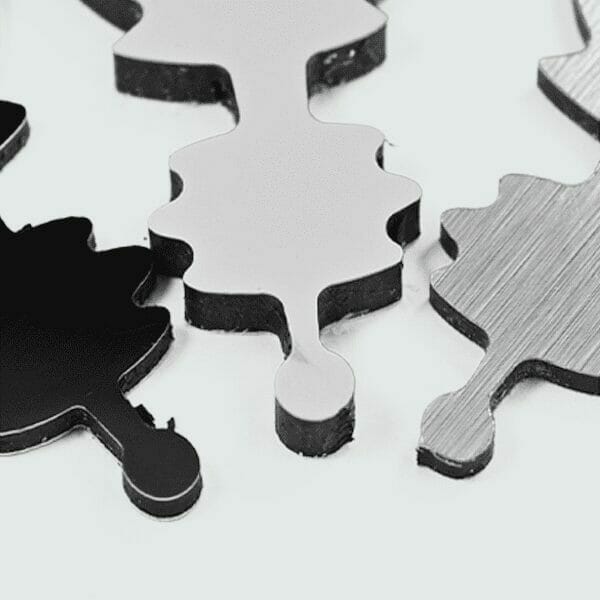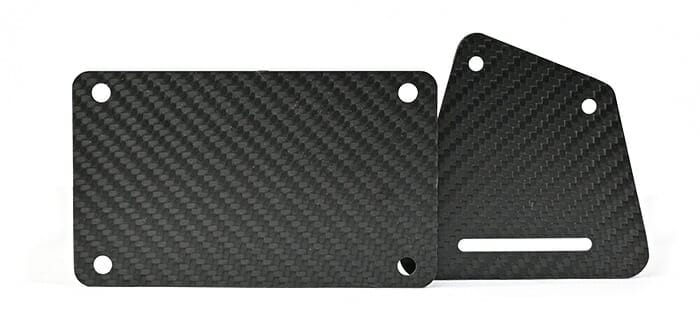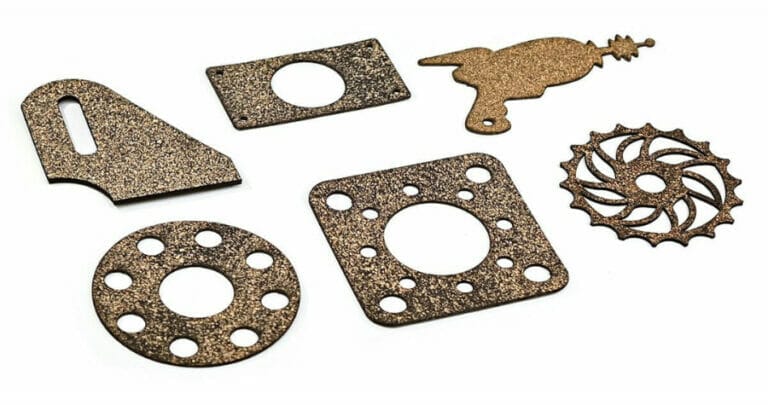If you’ve been browsing our material catalog and any plastic or metal we offer just doesn’t seem quite to fit the bill, this article is for you. Composite materials are the oddballs of the material world; entirely different from Metals, Plastics, and one another to a point that they are practically incomparable. In this article, we will break down the five composites we offer: ACM, Carbon Fiber, Cork, G10/FR-4, and Le Phenolic, and try to make sense of what these materials are best used for.
Article contents:
- Overview of all Composites we offer
- Cost Comparison
- Cutting Process
- Materials Properties Data Resources
SendCutSend Composites Breakdown
ACM (Aluminum Composite Material)
Cutting process: CNC Routing

Pros:
ACM also known as e-panel or DiBond® is a low-cost, lightweight cousin of aluminum. We offer the material in matte white, matte black, and brushed allowing you to obtain the strengths and aesthetics of aluminum at half the weight. Composed of two sheets of aluminum sandwiched with a polyethylene core, this fire-resistant composite is made out of 80%+ recycled materials making it as sustainable as it is good-looking.
Cons:
As with many of the composites we offer, this material can’t be deburred, bent, tapped, or powder coated and isn’t particularly easy to machine by hand due to the sandwiched nature of its construction. It also can’t be welded in the way that traditional aluminum is so be wary of that if you are a metalworker looking to use ACM as an aluminum alternative.
Typical Uses:
- Used as building cladding in construction
- Visual merchandising
- Machine enclosures
- Framing
- Signs and graphics
Carbon Fiber
Cutting process Waterjet

Pros:
Carbon Fiber has exploded in popularity over the last few years taking over our cars, bikes, and wallets with good reason. The composite offers an unmatched marriage of strength, rigidity, and light weight to be stronger than steel at a fraction of the weight. Our 2×2 twill weave offering is matte finish, corrosion-resistant, and absorbs impact energy due to its remarkable rigidity. If you are looking for an application that demands some extreme strength, we can’t recommend carbon fiber enough. Additionally, the material we use is a much higher quality than the aesthetic trim pieces you see in many cars nowadays so we recommend diving further into the material and its attributes if you are uninitiated.
Cons:
The biggest advantage to Carbon Fiber is also often its biggest downside depending on your application. The material is so unfathomably rigid that it can often cause problems in larger mechanisms and structures that are designed to flex. While it absorbs impact quite well itself, it can often direct that impact into attached parts which is something to look out for. The other thing to be careful with when choosing carbon fiber is it’s cost and machinability. The material, especially at higher thicknesses, can get expensive since it becomes increasingly difficult to produce and manufacture as it gets thicker. Because of the cost factore and the way the material is laid, we don’t recommend using this for applications/prototypes that are going to require a lot of machining on your end as drilling holes or cutting it is both quite difficult and can sacrifice a lot of the material’s integrity if not done correctly. If you are doing a large, untested order in carbon fiber, we highly recommend ordering a prototype in an alternate material to make sure everything fits together exactly as needed and before transitioning to carbon fiber. We often consider a test run like that an insurance policy on a substantial order and has saved us on our own projects time and time again. Carbon fiber also cannot be Deburred, Bent, Tapped, or Powder Coated due to its rigidity.
Typical Uses:
- Aerospace
- Dashboards
- Combat robotics protective paneling
- Anything requiring extreme rigidity, strength, and lightweigtedness
Cork (Gasket Grade)
Cutting process: Laser Cut
Pros:
Cork is somewhat an oddball material even inside of the diverse composites lineup. While most of the materials we offer are meant to serve some sort of structural function, cork is used almost exclusively for seals, aesthetics, and impact/vibration dampening. The material is incredibly workable, attractive, leak-free, and durable in addition to being one of our most sustainable and environmentally friendly options. Its 10/20 composition makes it great for high compression applications all the way down to low flange pressures and high temperatures.
Cons:
Just like every composite in our lineup, Cork serves a purpose. In this case, a very distinct purpose. Corks strength, generally speaking, is about 1/ that of carbon fiber making it not suitable for any sort of strength conducive application. Therefore, we recommend using cork for its typical applications and being wary of using it for anything outside of its general use cases.
Typical Uses:
- High compression applications
- Gaskets and pressured seals
- Automotive
- Plumbing
- Machining
- Decorative and aesthetics projects
- Anti-vibration panels
G10/FR-4
Cutting process Waterjet

Pros:
G10/FR-4 is widely considered a go-to material for electronics and robotics due to its specialized electrical properties, excellent dimensional stability, lightweight, fire retardancy, and chemical resistance. It is the best and most widely used electrical insulator we offer in addition to having incredibly high mechanical strength and rigidity. The material also is resistant to water absorption making it a popular choice for harsh marine environments.
Cons:
G10/FR-4 is often compared to Carbon Fiber due to its similarly woven construction and relatively similar material properties. While this is true, it’s about 25% denser and twice as weak as carbon fiber. This means that while its rigidity, strength, and weight are still exceptional, Carbon Fiber is very much in a league of its own when it comes to these attributes. The other major design consideration with G10 is that the weave differs from that of Carbon Fiber. What this means is unlike Carbon Fiber where the weave is so strong that we can’t measure a difference based on the direction of force, the strength, and rigidity of G10 are going to differ based on whether it’s lengthwise or crosswise against the weave. While that isn’t a major issue, it’s something to pay attention to if you are going to have forces in one direction that are substantially different magnitudes and how the force strains the part as you may want to manufacture your part in a specific orientation. Additionally, this material is not suited for hand machining just like Carbon Fiber so we recommend making sure your designs are completely accurate with a prototype before committing to a large G10/FR-4 order.
Typical Uses:
- Electronic parts
- Robotics
- Marine applications
- Insulating washers and transformer components
- Firearm and knife grips
LE Phenolic Linen (Micarta
Cutting process: Waterjet

Pros:
Le Phenolic Linen is a high-density mixture of phenolic resin and fine weave cotton cloth that creates a composite with major insulating capabilities and remarkable creep resistance. While these make it a great choice for electrical applications, the material is also impact resistant, moisture resistant, and easily machinable. Additionally, LE Phenolic features physical toughness, abrasion, friction, and impact resistances which coupled with great fatigue strength makes it a lightweight alternative to aluminum for many applications.
Cons:
Although Le Phenolic is the second lightest composite we offer, its strength does not hold a candle to materials like G10/FR-4 or Carbon Fiber and we, therefore, do not recommend it for those sorts of use cases. It is, however, very comparable to some of the plastics we offer like Delrin so we recommend considering using it when looking for an aluminum or plastic alternative that behaves remarkably in wet or corrosive environments where aluminum or some plastics may not.
Typical Uses:
- Extremely humid environments
- Where strength is as important as corrosion resistance
- Mechanical parts
- Countertops
- Propeller blades
- Terminal bases & strips
- Gears, pulleys, rollers and other mechanical parts
Cost Comparison of SendCutSend Composite Materials

Unlike plastics, comparing costs with composites is difficult to do as each one is used for such different applications. Additionally, each price listed here is given in the thinnest variety of the respective material that we offer at the time of writing. Therefore, you may find that a suitable thickness for your application comes at a substantially different price which is something to keep in mind when comparing these materials. Generally speaking, however, the thinnest option we offer in each material is the thinnest we would recommend going for any application so just keep that in mind. At the end of the day, we don’t recommend picking a composite based on price since Cork is in no way an alternative to Carbon Fiber. We sooner recommend comparing the costs of composites, plastics, and metals you are interested in using our instant pricing tool to help you better weigh your options.
Cutting Process on Composite Materials
One major thing to consider when choosing a composite against a plastic or metal material is the manufacturing process. ACM uses the CNC router, Cork is laser cut, and the rest of the materials are cut on a waterjet. The vast majority of the materials we offer are cut on the laser cutter so it’s important to compare the CNC guidelines to the laser cutter and waterjet guidelines. Fortunately, the waterjet and laser cut guidelines are nearly interchangeable with few discrepancies and our process handles things like kerf compensation and other complex manufacturing discrepancies. For CNC, however, the guidelines do vary quite a bit and are a little bit more demanding as far as restrictions so we recommend reading those guidelines thoroughly before committing to a material cut on the CNC route as it’s not fit for some scales and design features commonly used for certain applications.
Material Properties Cheat Sheet
The technical language surrounding material properties can be overwhelming, so we’ve put together this helpful cheat sheet so you know exactly what to expect from your chosen material! The specific properties for each material can be found in the “Properties” section of that material’s page. Be sure to check out our Material Min/Max chart as well to find the geometry requirements for each of our high-quality materials.
Density: How much something weighs relative to its size. This is an important attribute to consider as some of our plastics are considerably heavier than others.
Tensile Strength(Ultimate): The amount of stress that a material can withstand without breaking. This is a good indicator of how “strong” a part will be when a force pushes perpendicular to its surface.
Comprehensive (Crushing) Strength: How much force a part can withstand when being crushed. Strength like this is important to consider in scenarios where you have plates pushing against each other. A common example of this would be HDPE or UHMW used as skid plates in order to decrease the friction between two plates. If those plates don’t have high comprehensive strength, the part may crack from the force of the plates it’s separating.
Flexural Strength: How strong a part is right before it breaks. If you are designing a plate that is intended to bend this is an important attribute to consider as it’s a good indicator of how much integrity the part will retain as it’s being bent.
Shear Modulus: The material’s ability to resist small deformations over time. This is not in relation to bending but rather just the ability of the material to hold its form over time.
Impact Strength (Notched Izod): A measure of how much impact a material can withstand on one single pressure point. This sort of attribute is often looked at for things that will receive impact from fast-moving debris or will frequently receive force from one single point. A good example of this would be a rock flying at a windshield or window.
Rockwell Hardness: Simply the hardness of the plastic. The higher the number, the harder the plastic is. A harder plastic will be less prone to scratches and dents but also tends to be more rigid and more prone to shattering.
Elongation at Break: How much the material stretches when being bent to its breaking point in comparison to its original length. There is no good or bad number when it comes to elongation at break, it’s solely dependent on your application. If you have an application where you’d want the material to stretch rather than break, you want a higher elongation while if rigidity and the part holding its form is more important you want a lower percentage.
Elastic Modulus: Measure of a material’s elasticity meaning its ability to be deformed and return to its original state. Think of a rubber band and how it’ll stretch and return to its original size and shape until it eventually breaks. The higher the Elastic Modulus, the longer before it breaks.
Thermal Conductivity: The ability of a material to transfer heat from one side of your part to another. The higher the thermal conductivity, the more efficiently/quickly your part will be able to transfer heat.
Melting Point: When it comes to plastics, this is the same as decomposition temperature. Just like an ice cube turning into water, this is the temperature at which the material will either melt into a liquid or separate into multiple different liquids/materials. Simply put, the material will no longer be in its original state at and beyond this temperature.
Fatigue Strength: The most amount of stress that a material can withstand for a given number of cycles without breaking. The higher the strength, the more stress it can endure over time.
Flexural Modulus: The tendency of a material to bend. The higher the Flexural Modulus, the more the material will bend to withstand a force rather than strain statically.
Electrical Resistivity: How strongly a material will resist an electrical current.
Maximum Temp (Mechanical): A maximum operating temperature. If you make a geared mechanism, for example, this is the maximum temperature where those pieces will hold their form and function correctly.
Vicat Softening Temperature: The determined softening point of a material that has no definite melting point. For plastics that decompose, this is the temperature where the material will start to deform.
Tensile Strength (Yield): The stress a material can withstand without permanent deformation. While Ultimate Tensile Strength specifies a breaking point, Yield represents a point where the material will be bent/deformed to a point where it won’t return to its original dimensions.
Dielectric Strength (V/mil) 1/8″: The maximum electric field that an insulating material, the plastic, in this case, can withstand.
Continuous Service Temp (Operating), °F : The maximum temperature in the air at which a material can withstand and maintain 50% of its strength.
Shear Strength: This refers to a material’s strength against a structural failure caused by a shear load which is a force applied tangent to the surface of your part.
Yield Tensile Elongation: How much a material will stretch under tension. This refers to the amount a material can stretch before permanent deformation.
Coefficient of Friction: In basic terms how slippery a material is. A common reason to use plastic is because of its relatively low coefficient of friction, especially when looking at materials like UHMW which is used primarily for this reason.
Heat Deflection Temp: Measure of a material’s resistance to a change in its shape under a given force at an elevated temperature. If I heat up my part and try to bend it, for example, this is a measure of how well the part will withstand that force in comparison to how it would in normal operating conditions.





